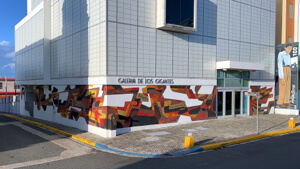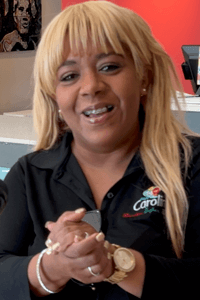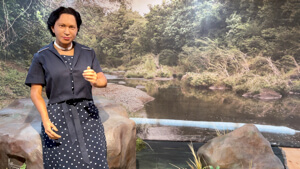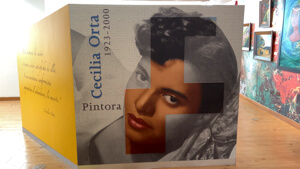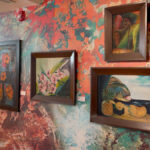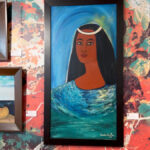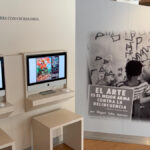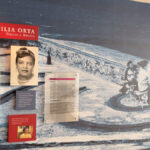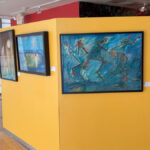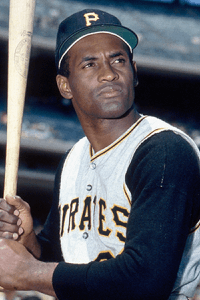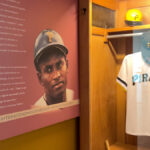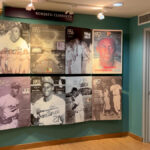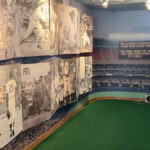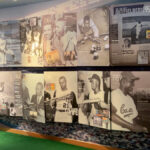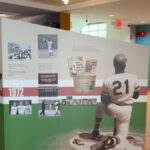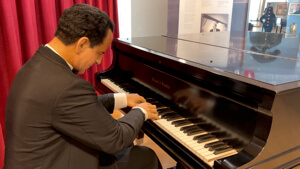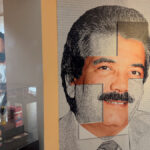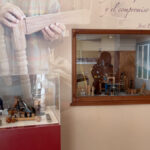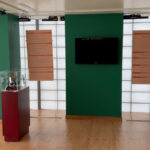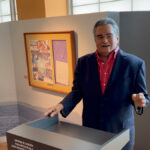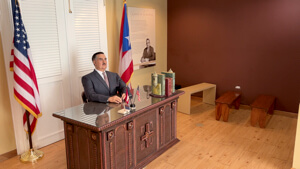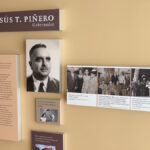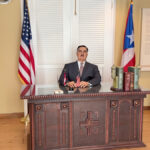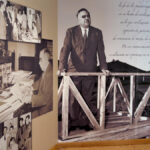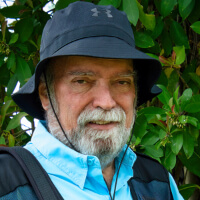Having 78 municipalities, and preserving harmony and sanity, is hard. Every town wants to be the the first, the largest and the greatest. But that’s imposible in itself because some towns are simply small, not everyone can be first and greatness… well, that’s a combination of God-given talent and perseverance. . In this competitive landscape called Puerto Rico there’s an entire town that’s made up of giants. Not because of their size (Puerto Rican males average 5’10″ and females average 5’3”), but because of their genius and mettle. And the “Galería De Los Gigantes” (Gallery of Giants) celebrates that town’s legacy!
Gallería De Los Gigantes is a museum located on the corner of Ignacio Arzuaga and José de Diego streets in the original town of Carolina (18.381256, ‑65.957089), right next to the original Town Hall building.
The museum is dedicated to eight prominent figures that brought glory to Carolina, including: Felipe Birriel Fernández, the original “Carolina Giant” (more on him in a minute); Julia de Burgos, poetess; Roberto Alberty “El Boquio”, poet, painter, photographer and creator of objects; Roberto Clemente Walker, world famous major league baseball player; Cecilia Orta, painter and educator; Jesús T. Piñero, the first Puerto Rican-born governor of the Island appointed by the president of the United States; Jesús María Sanromá, classical pianist and José E. Aponte de la Torre, educator and former mayor of the City.
Each one of these illustrious “carolinences” made significant contributions towards the betterment of the City and of Puerto Rico as a whole.
The museum is open Wednesdays thru Saturdays from 10:00am to 5:00pm and Sundays from 12:00pm to 5:00pm. Admission is only $4.00 per person, but you can get an even sweeter deal if you combine your visit with the Museum of Technology and Art (Museo de Tecnología y Arte) across the street. And to complete your day you can visit “Casa Escuté”, a third museum dedicated to fine art itinerating exhibitions that sits between the two. Oh, and Casa Escuté is free, so it will make the deal even sweeter.
Entering the “Galería De Los Gigantes” I met with Mrs. Michelle Gil, Director of the Carolina Tourism Development and Culture Department, who was our private guide to all three museums. Additionally, we had specialized guides at each museum that covered individual aspects.
The first room on the left, upon entering the museum, was an itinerating gallery with a small photography exhibit dedicated to famous jazz musicians that have performed throughout the years in the town’s different cultural events.
Leaving the first gallery there’s a small gift shop with memorabilia of many of the figures exalted throughout the museum.
From there we caught an elevator to meet with “the man” himself: Felipe Birriel Fernandez, “el gigante de Carolina” (the Carolina Giant) who stood 7’ 11” tall. Birriel was born in Carolina on August 16, 1916, to Pedro Birriel and Dionisia Fernández. He was the oldest of six children. In spite of the height that Felipe finally reached, he was not a “normal” giant, like the ones we see today in the NBA.
At the age of 16 his parents noticed that Felipe was growing abnormally fast. He was also weak and suffering from dizzy spells. So off he went to the doctor. He was diagnosed with a rare condition affecting his pituitary gland that had developed into a tumor. The doctor told the Birriels that there wasn’t a cure for the condition, but it could be treated with radiation in the United States.
Instead of rushing Birriel to be treated on the mainland the government ordered the machine to treat him locally. However, the order was placed in 1932 and it wasn’t until 1941 (nine years later) that he finally received treatment.
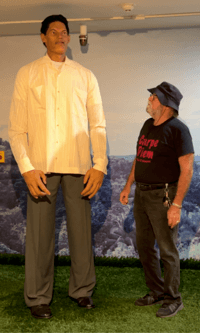
Orlando Mergal standing next to the Felipe Birriel Fernández animatronic figure (click on image to see it larger)
At 7’ 11″ tall Birriel was not only the tallest man in Puerto Rico but also among the tallest in world history.
I actually met the man back in the latte 70’s when I was selling insurance near his home in the Barrazas ward of Carolina. At 6’ 0″ I felt like a midget next to him.
Birriel only got to second grade in elementary school. That was typical in his time for regular children coming from poor families. Now imagine being abnormally tall and actually suffering from a serious medical condition.
Yet Birriel wasn’t bitter or nasty. Instead he was a humble, friendly and outgoing person who’s giving nature made him a symbol for Carolina then and now. “Carolinences” aren’t giants because they’re tall, they’re giants because of their talent and determination.
Back to the museum. When you enter the Felipe Birriel Fernández gallery you’re met by an animatronic figure of the man that invites you in and tells you a little bit about the museum. You can also take your picture next to him. And believe me, you’ll feel small no matter how tall you are.
Next we visited the Julia de Burgos exhibit. Julia Constancia Burgos García was born in the town of Carolina on February 17, 1914. She was one of Puerto Rico’s most accomplished poets.
But she was so much more. She was truly a woman ahead of her time Throughout her life she defended independence for the Island, in a time when women were expected to be homemakers, and served as Secretary General of the Daughters of Freedom, the women’s branch of the Puerto Rican Nationalist Party.
She was also an advocate for women’s rights and African/Afro-Caribbean writers.
In 1935, while working as a teacher in the town of Naranjito, a small town about 27 miles southwest of Carolina, she wrote her most famous poem titled “Río Grande De Loíza”, which is Puerto Rico’s largest river and divides the town of Carolina from the neighboring town of Loíza.
Maybe she was homesick. Who knows? The thing is that it was also her most beautiful work. So much so that the animatronic figure at the “Museo De Los Gigantes” actually recites the entire piece.
Next was Cecilia Orta. Orta was born on October 21, 1923. She was the daughter of Raymundo Orta, a bricklayer, and Cecilia Allende, a housemaid and seamstress. She was the fifth of eight siblings.
Orta’s father didn’t want her to be a painter so she ended up training in Home Economics at the University of Puerto Rico. Upon her graduation, she was hired by the Puerto Rico Department of Education in 1949 to offer art classes. In 1953 she obtained a scholarship to study plastic arts at the National Autonomous University of Mexico, where she studied with the great masters of muralism, among them Diego Rivera, husband of the also painter Frida Kahlo.
Upon returning to Puerto Rico in 1955, Orta founded the Academy of Plastic Arts of the Future Painters of Puerto Rico. With this rolling school she visited several towns and schools where she was invited to bring the knowledge of art to all the children for free. One of her favorite phrases was: “Art is the best weapon against crime.” Because of her intense love for the plastic arts, Cecilia Orta Allende proclaimed herself “The People’s Painter”.
- Cecilia Orta original paintings (click on image to see it larger)
- Cecilia Orta original paintings (click on image to see it larger)
- Cecilia Orta’s work as a teacher (click on image to see it larger)
- Cecilia Orta’s work as a teacher | (click on image to see it larger
- Cecilia Orta original paintings (click on image to see it larger
- Cecilia Orta original paintings (click on image to see it larger
The gallery contains a large collection of original pieces as well as information about her illustrious life.
The next gallery was dedicated to Roberto Clemente Walker. Clemente was born on August 18, 1934. He was a Major League Baseball Right Fielder who played 18 seasons with the Pittsburg Pirates.
On December 31, 1972 Clemente met his maker while delivering relief supplies to the victims of a major earthquake in Manuagua, Nicaragua. One year later, in 1973, he was posthumously inducted into the National Baseball Hall of Fame, becoming both the first Caribbean and the first Latin-American player to be elevated to that prestigious level.
Clemente was selected an all-star for 13 consecutive seasons. He was also the National League’s Most Valuable Player (MVP) in 1966, batting leader in 1961, 1964, 1965 and 1967 and Golden Glove winner for 12 consecutive seasons from 1961 to 1972. His batting average never went below .300 during 13 consecutive seasons. He also batted his hit number 3,000 just three months prior to his untimely death.
But Clemente wasn’t just about baseball. He was also a humanitarian. So much so that he met his death while helping our Nicaraguan brothers during one of their darkest moments. The plane he boarded was basically a piece of junk. But Clemente did it anyway because of the pressing need of our Nicaraguan brothers. He also delivered food and sports equipment during the off season both in Puerto Rico and in neighboring Latin American countries.
The following season, the Pirates retired his uniform number 21, and MLB (Major League Baseball) renamed its annual Commissioner’s Award in his honor. Now known as the Roberto Clemente Award, it is given to the player who “best exemplifies the game of baseball, sportsmanship, community involvement and the individual’s contribution to his team.”
- Click on image to see it larger.
- Click on image to see it larger.
- Click on image to see it larger.
- Click on image to see it larger.
- Click on image to see it larger.
- Click on image to see it larger.
And speaking of number 21, did you know that Clemente chose the number 21 because his full name “Roberto Clemente Walker” had that many letters? Guess what? I didn’t know that either.
And here’s another piece of trivia for you. As you leave the “Galería De Los Gigantes” (after you’re finished exploring the whole thing, of course) there’s a catholic church to your left. It’s the San Fernando Church (18.381085, ‑65.956427). Well, that’s where Roberto Clemente Walker married his wife Vera Zabala on November 14, 1964. Ask your museum guide for more great Clemente trivia.
If you want to go back in baseball history, and stand before true greatness, this is one exhibit that you absolutely need to see!
Across the way from Roberto Clemente Walker is the Jesús María Sanromá gallery. Sanromá was a child prodigy pianist born in the town of Carolina on November 7, 1902 to José María Sanromá and María Torra de la Riba. While he was just a child, Jesús María used to play on his father’s piano while the former was working. One day his father came back from work and caught the young Jesús María playing.
Realizing that his son had talent, José enrolled him in piano lessons in the neighboring town of Fajardo, about 28 miles southeast of Carolina. Twenty eight miles sounds close by today’s standards, but back in the 1900’s it was quite a trip.
In 1913, at the age of 11, Jesús María made his piano debut at the Fajardo Municipal Theater. Sanromá worked with various composers throughout his career, like Igor Stravinsky and Sergei Prokofiev, but it was the future conductor of the Boston Pops Orchestra, Arthur Fiedler, with whom he developed an artistic relationship that lasted for years.
Jesús María Sanromá is considered one of the five most accomplished and important pianists of the 20th century.
During his later years he cofounded the Puerto Rico Conservatory of Music with his friend and world renown cellist Pablo Casals.
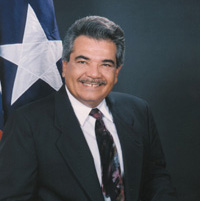
José Aponte de la Torre
José Aponte de La Torre was born in Cayey, Puerto Rico on December 5, 1941. He is the only “giant” at the “Galería de los Gigantes” that wasn’t born in Carolina. He was also the mayor of the town from 1984 until his death on May 5, 2007.
While not being actually born in Carolina, Aponte was “baptized” as “el gigante mayor” (the greatest giant) by the townspeople because of the love and respect that he earned among them.
During his tenure the town experienced continued growth and has continued to do so during his son’s tenure to date, Mayor José Carlos Aponte Dalmau.
José Aponte was an industrial arts teacher by trade, a devoted woodworker and an honest politician, two words that we seldomly hear together in modern times.
- (click on image to see it larger)
- (click on image to see it larger)
- (click on image to see it larger)
- José Aponte de la Torre animatronic figure (click on image to see it larger)
As an adoptive “carolinence” for 35 years, I can attest to the progress that Aponte de la Torre brought to Carolina. And so far (it has been 15 years since his death) his son seems to have inherited the better traits of his father.
Jesús Toribio Piñero Jiménez was born in Carolina on April 6, 1897 to Emilio Piñero and Josefa (Pepita) Jiménez Sicardó. His school years took place in the town of Carolina and his college years at the University of Puerto Rico, in the neighboring town of Río Piedras. And here’s a piece of trivia for you. Río Piedras was actually a separate town when Jesús T. Piñero went to college.
Later on he studied engineering at the University of Pennsylvania.
Piñero was always drawn towards technology. He was a ham radio aficionado, as well as a photography and filmography enthusiast. In fact, he actually built Puerto Rico’s first ham radio station at home and founded the “Porto Rico Radio Club” back in 1922.
But what really sealed his fate as a “gigante” was the fact that he was the first Puerto Rican to be appointed governor of the Island in 1946, after the U.S. invaded the Island back in 1898. Before Piñero all the governors under United States rule had been mainlanders.
- Click on image to see it larger.
- Click on image to see it larger.
- Click on image to see it larger.
He was one of the founding members of the Popular Democratic Party with his friend Luis Muñoz Marin, who in 1948 would become the first Puerto Rican-born governor to be elected by the people of Puerto Rico under the insignia of the Popular Democratic Party.
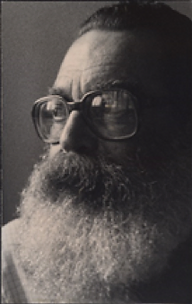
Roberto Alberty El Boquio
And finally we arrived at the Roberto Alberty El Boquio gallery. Alberty was another child prodigy born in Carolina on January 24, 1930. From an early age he impressed people with his vivid imagination. His work combines painting, poetry, photography and recycled objects from everyday life.
The “Galería de los Gigantes” is one of those places that holds lots and lots of information in a well designed and friendly layout. You can be all day learning about Carolina’s “gigantes”, but a more practical approach would be to combine it with the Museum of Technology and Art (Museo de Tecnología y Arte), across the street, and the Casa Escuté to the front right of the building. That’s what my wife and I did and we had a great time.
Oh, and don’t forget to stop by the gift shop for some excellent memorabilia. And if you’re not a diabetic like me, they also have an excellent coffee shop at the Museum of Technology and Art.
The museum has excellent guides that conduct tours both in Spanish and English. For more information call the Carolina Department of Tourism and Culture at 787–757-2626, ext 3903 and 3946.
Finally, If you liked this page, and you plan to visit Puerto Rico —and the town of Carolina— in the near future, you’ll find ample information on this website. You can also book flights, hotels & car rentals at great prices through the widgets on the right hand column.
And yes, they are affiliate links. That means that I make a small commission, while you pay exactly the same that you’d pay anywhere else. That way you get to return the favor without spending an extra dime.
Enjoy Puerto Rico,
©2022,Orlando Mergal, MA
____________________
Bilingual Content Creator, Blogger, Podcaster,
Author, Photographer and New Media Expert
Tel. 787–750-0000, Mobile 787–306-1590

